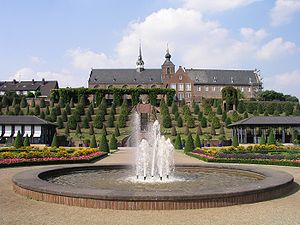
Kamp Abbey
Encyclopedia

Germany
Germany , officially the Federal Republic of Germany , is a federal parliamentary republic in Europe. The country consists of 16 states while the capital and largest city is Berlin. Germany covers an area of 357,021 km2 and has a largely temperate seasonal climate...
territory, in the present town of Kamp-Lintfort
Kamp-Lintfort
Kamp-Lintfort is a town in Wesel District, in North Rhine-Westphalia, Germany. It is located 8 km north-west of Moers.- Twin towns :Kamp-Linfort is twinned with the town of Chester-le-Street in the North East of England....
in North Rhine-Westphalia
North Rhine-Westphalia
North Rhine-Westphalia is the most populous state of Germany, with four of the country's ten largest cities. The state was formed in 1946 as a merger of the northern Rhineland and Westphalia, both formerly part of Prussia. Its capital is Düsseldorf. The state is currently run by a coalition of the...
.
History
It was founded in 1123 by Friedrich I, Archbishop of Cologne, and settled from Morimond AbbeyMorimond Abbey
Morimond Abbeyis a religious complex in Parnoy-en-Bassigny, Haute-Marne department, in the Champagne-Ardenne region of France. It was the fourth of the four great daughter abbeys of Cîteaux Abbey, of primary importance in the spread of the Cistercian Order, along with La Ferté to the south,...
. As the first Cistercian foundation in the region it attracted great endowments and became very wealthy and powerful. It was extremely active in the foundation of daughter houses:
- In Germany: Walkenried AbbeyWalkenried AbbeyWalkenried Abbey was one of the most celebrated Cistercian abbeys of Germany, located in the village of Walkenried in the district of Osterode in Lower Saxony, Germany.-History:...
(1129); Amelungsborn AbbeyAmelungsborn AbbeyAmelungsborn Abbey, also Amelunxborn Abbey near Negenborn and Stadtoldendorf, in the Landkreis of Holzminden in the Weserbergland, was the second oldest Cistercian foundation in Lower Saxony, Germany, after Walkenried Abbey...
(c.1129); Volkenroda AbbeyVolkenroda AbbeyVolkenroda Abbey is a former Cistercian monastery in the municipality of Körner in the Unstrut-Hainich district of Thuringia, Germany.-History:...
(1131); Hardehausen AbbeyHardehausen AbbeyHardehausen Abbey is a former Cistercian monastery located near Warburg in the district of Höxter in the east of North Rhine-Westphalia, Germany.-History:...
(1140); Michaelstein AbbeyMichaelstein AbbeyMichaelstein Abbey is a former Cistercian monastery, now the home of the Stiftung Kloster Michaelstein - Musikinstitut für Aufführungspraxis , near the town of Blankenburg in the Harz in Sachsen-Anhalt, Germany.-History:In a deed of Emperor Otto I dated 956 giving property to...
(1146); Saarn Abbey (1214); Neuenkamp Abbey (1231); Bottenbroich AbbeyBottenbroich AbbeyBottenbroich Abbey, later Bottenbroich Priory , was a former Cistercian religious house located in Bottenbroich, now in Frechen, about three kilometres north-east of Kerpen, in the present Rhein-Erft-Kreis of North Rhine-Westphalia, Germany.-History:...
(1231); Burlo Abbey (1448); and Grevenbroich Abbey (1628);
- In the Netherlands: Eiteren Abbey (1342); Mariënkroon Abbey(1382); and Sibculo Abbey (1412).
Kamp was largely rebuilt in the 15th century but suffered extensive damage in the Reformation
Protestant Reformation
The Protestant Reformation was a 16th-century split within Western Christianity initiated by Martin Luther, John Calvin and other early Protestants. The efforts of the self-described "reformers", who objected to the doctrines, rituals and ecclesiastical structure of the Roman Catholic Church, led...
. The abbey was abandoned early in the Cologne War
Cologne War
The Cologne War devastated the Electorate of Cologne, a historical ecclesiastical principality of the Holy Roman Empire, present-day North-Rhine-Westphalia, in Germany...
(1583–1588); many of the monks went to the city of Neuss, where they underwent the siege and bombardment of July 1586; another portion went to Rheinberg
Rheinberg
Rheinberg is a town in the district of Wesel, in North Rhine-Westphalia, Germany. It is situated on the left bank of the Rhine, approx. north of Moers and south of Wesel....
, which was the focus of three battles to take the city, the last in 1589. The abbey itself was destroyed by Adolf von Neuenahr
Adolf van Nieuwenaar
Adolf van Nieuwenaar, Count of Limburg and Meurs was a statesman and soldier, who was stadtholder of Gelderland and Utrecht for the States-General of the Netherlands during the initial stages of the Eighty Years' War.-Early life:Nieuwenaar was the son of Count Gumprecht II von...
in 1586. A small group of monks returned under abbot Polenius (1636–64), but re-construction did not begin until 1683, and the community did not return fully until 1700.
The abbey was secularised during the German mediatisation
German Mediatisation
The German Mediatisation was the series of mediatisations and secularisations that occurred in Germany between 1795 and 1814, during the latter part of the era of the French Revolution and then the Napoleonic Era....
of 1802 and the buildings were sold, and mostly demolished. The church was converted for use as a parish church.
Between 1954 and 2002 a Carmelite community resided on the remains of the monastery.
The abbey site is still known for the terraced gardens and the orangeries.

